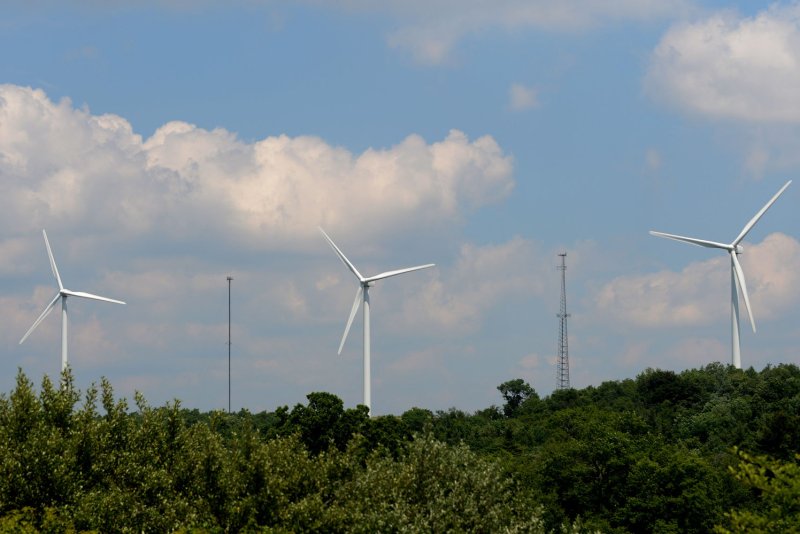The angles of wind turbines relative to the horizon -- their yaw -- must continually adjust to prevent their wakes from disrupting the efficiency of their neighbors. File Photo by Pat Benic/UPI |
License Photo
July 20 (UPI) -- Clustering wind turbines can help power producers generate more electricity while taking up less space. Unfortunately, the air turbulence created by a spinning wind turbine -- sometimes called its wake -- can disrupt the efficiency of the turbine's neighbors.
According to a new study, published Tuesday in the journal of Renewable and Sustainable Energy, scientists have developed a new data analysis method to help wind farm operators adjust the yaw of clustered turbines to avoid interference.
Simulations showed the new method, which requires no new sensors, can provide a 1% to 3% boost of energy.
"There was a huge gap in how to determine, automatically, which turbine is in the wake of another in the field with variable wind conditions," co-author Stefano Leonardi said in a press release.
"This is what we solved. This is our contribution," said Leonardi, a researcher with the Center for Wind Energy at the University of Texas at Dallas.
When building and managing wind farms, operators must consider a variety of factors, such as topography and temperature, when optimizing the energy production of each individual turbine. But engineers must also consider how each turbine effects those around them.
The wake from an upwind turbine can reduce the power production of a turbine downwind by as much as 60 percent.
One of the tools that can be used to optimize an individual turbine's power production is its yaw, the turbine's angle relative to the horizontal plane. A turbine's yaw can also be adjusted to reposition its wake away from downwind neighbors.
Unfortunately, wind conditions frequently change. To keep turbines optimized and wake-free, yaws must be adjusted as the wind changes.
For the new study, scientists showed how data already being collected by turbine sensors can be used to inform yaw adjustment. Models suggest the automatic yaw adjustment system can boost a wind farm's power production by 1 percent.
If adopted industry-wide, such an increase in production would translate to 3 billion kilowatts per year.
"The exciting part about our work is that it matches reality, impacting real people," said study co-author Federico Bernardoni. "Operators can use these results to identify when they should apply yaw control, and to which group, to maximize wind power gain."
The data analysis system, however, is not a model, as it makes no assumptions about environmental conditions. The system works by analyzing data fielded directly from the individual turbines that make up a wind farm.
"By just making turbines smarter, we're getting more energy from something that already exists," said Leonardi. "Using just simple math, we're increasing energy, so that's a very clean, green 1% to 3%."















